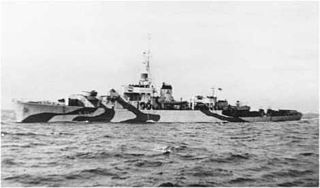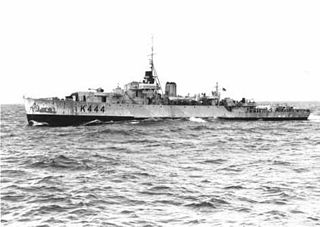
The Flower-class corvette was a British class of 294 corvettes used during World War II by the Allied navies particularly as anti-submarine convoy escorts in the Battle of the Atlantic. Royal Navy ships of this class were named after flowers.

HMCS Sackville is a Flower-class corvette that served in the Royal Canadian Navy and later served as a civilian research vessel. She is now a museum ship located in Halifax, Nova Scotia, and the last surviving Flower-class corvette.

HMCS Rimouski was a Royal Canadian Navy Flower-class corvette which took part in convoy escort duties during the Second World War. She fought primarily in the Battle of the Atlantic. She was named after Rimouski, Quebec.

HMCS Kitchener was a Royal Canadian Navy revised Flower-class corvette which took part in convoy escort duties during the Second World War. She fought primarily in the Battle of the Atlantic. She was named for Kitchener, Ontario. The vessel was originally named HMCS Vancouver but was renamed in November 1941 before the ship was launched.

HMCS Alberni was a Flower-class corvette that served in the Royal Canadian Navy (RCN) during the Second World War. The Flower-class corvettes were warships designed for anti-submarine warfare. The ship was constructed by Yarrows Ltd. in Esquimalt, British Columbia, laid down on 19 April 1940, launched on 22 August and commissioned on 4 February 1941. The corvette sailed east to join the RCN's fleet in the Atlantic via the Panama Canal, where upon arrival, the vessel began escorting trans-atlantic convoys in the Battle of the Atlantic. Alberni took part in the key convoy battle of Convoy SC 42. In 1942, the corvette was transferred to Allied convoy assignments associated with Operation Torch in the Mediterranean Sea. In 1944, Alberni was among the Canadian naval vessels assigned to Operation Neptune, the naval component of the invasion of Normandy and escorted support ships to and from the United Kingdom on D-day.

HMCS Moose Jaw was a Royal Canadian Navy Flower-class corvette which took part in convoy escort duties during the Second World War. Together with HMCS Chambly, she achieved the RCN's first U-boat kill of the war. She was named after Moose Jaw, Saskatchewan.

HMCS Regina was a Royal Canadian Navy revised Flower-class corvette which took part in convoy escort duties during the Second World War. She fought primarily in the Battle of the Atlantic. She was named for Regina, Saskatchewan.

HMCS Magog was a River-class frigate that served in the Royal Canadian Navy (RCN) during the Second World War. She was used primarily as a convoy escort. On 14 October 1944, she was torpedoed by U-1223. She survived the attack, was towed to port and declared a constructive total loss. Magog was named for the town of Magog, Quebec.

HMCS Kokanee was a River-class frigate that served in the Royal Canadian Navy during the Second World War. She saw action primarily in the Battle of the Atlantic as a convoy escort. After the war she was sold to India and converted into a pilot vessel.

HMCS New Glasgow was a River-class frigate that served in the Royal Canadian Navy during the Second World War and as a Prestonian-class frigate from 1955 to 1965. She was named for New Glasgow, Nova Scotia.

The River class was a class of fourteen destroyers of the Royal Canadian Navy (RCN) that served before and during the Second World War. They were named after Canadian rivers.

HMCS Halifax was a Royal Canadian Navy revised Flower-class corvette which took part in convoy escort duties during the Second World War. She served primarily in the Battle of the Atlantic. She was named for Halifax, Nova Scotia.

HMCS Moncton was a Flower-class corvette that served in the Royal Canadian Navy during the Second World War. She served on both coasts of Canada. She is named after Moncton, New Brunswick.

HMCS Charlottetown was a River-class frigate that served with the Royal Canadian Navy (RCN) during the Second World War. She was the second vessel of the name, HMCS Charlottetown having been a Flower-class corvette that had been sunk earlier in the war. They are unique for being the only two ships to have shared the same pennant number, K 244. She was named for Charlottetown, Prince Edward Island.

HMCS Fredericton was a Flower-class corvette of the Royal Canadian Navy. She was ordered from Marine Industries Ltd. in Sorel, Quebec and laid down on 22 March 1941. She was launched on 2 September 1941 and commissioned on 8 December 1941. She was named after the community of Fredericton, New Brunswick.

HMCS Arrowhead was a Flower-class corvette that was originally commissioned by the Royal Navy but served primarily with the Royal Canadian Navy (RCN) during the Second World War. She fought in the Battle of the Atlantic and the Battle of the St. Lawrence as a convoy escort. The vessel was named for sagittaria, which is an aquatic water plant that is sometimes known as arrowhead. Following the war, the ship was sold for mercantile use as a whaling ship and renamed Southern Larkspur. The vessel was broken up for scrap in 1959.

HMCS Chebogue was a River-class frigate that served with the Royal Canadian Navy during the Second World War. She served primarily as an ocean convoy escort in the Battle of the Atlantic. She was named for Chebogue, Nova Scotia. During the war she was torpedoed and declared a constructive loss.

HMCS Valleyfield was a River-class frigate that served with the Royal Canadian Navy during the Second World War. She served primarily as a convoy escort in the Battle of the Atlantic. She was torpedoed and sunk in May 1944, the only River-class frigate lost by the RCN. She was named for Salaberry-de-Valleyfield, Quebec.

HMCS Prince Rupert was a River-class frigate that served with the Royal Canadian Navy during the Second World War. She served primarily as a convoy escort in the Battle of the Atlantic. She was named for Prince Rupert, British Columbia.

HMCS Matane was a River-class frigate that served with the Royal Canadian Navy during the Second World War. She served primarily as a convoy escort in the Battle of the Atlantic. She was named for Matane, Quebec.



















